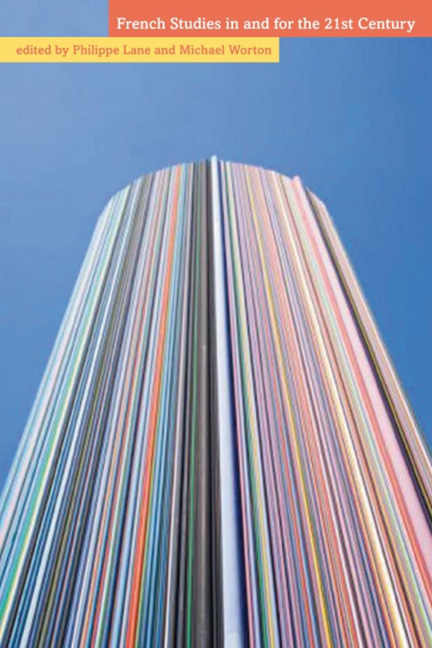Book contents
- Frontmatter
- Contents
- Notes on Contributors
- Foreword
- Foreword by His Excellency
- Part I: Contextualisations
- Part II: Research and Public Engagement Strategies
- Part III: The Place of Women and Gender in French Studies
- 6 Gender and the French Language: The longue durée of French Studies in the UK
- 7 Contemporary Women's Writing in French: Future Perspectives in Formal and Informal Research Networks
- 8 French Studies and Discourses of Sexuality
- Part IV: The Place of Literature
- Part V: The Place of Linguistics in French Studies Today
- Part VI: Theatre, Cinema and Popular Culture
- Part VII: Area Studies, Postcolonial Studies and War and Culture Studies
- Part VIII: Adventures in Language Teaching
- Appendices. Addresses to the Future of French Studies Conference
7 - Contemporary Women's Writing in French: Future Perspectives in Formal and Informal Research Networks
from Part III: The Place of Women and Gender in French Studies
- Frontmatter
- Contents
- Notes on Contributors
- Foreword
- Foreword by His Excellency
- Part I: Contextualisations
- Part II: Research and Public Engagement Strategies
- Part III: The Place of Women and Gender in French Studies
- 6 Gender and the French Language: The longue durée of French Studies in the UK
- 7 Contemporary Women's Writing in French: Future Perspectives in Formal and Informal Research Networks
- 8 French Studies and Discourses of Sexuality
- Part IV: The Place of Literature
- Part V: The Place of Linguistics in French Studies Today
- Part VI: Theatre, Cinema and Popular Culture
- Part VII: Area Studies, Postcolonial Studies and War and Culture Studies
- Part VIII: Adventures in Language Teaching
- Appendices. Addresses to the Future of French Studies Conference
Summary
In the UK and elsewhere in the anglophone world, contemporary literature in French continues to be a strong field of study in both research and teaching. Traditionally lone scholars, researchers of literature are now increasingly being pressured by their institutions to network, to collaborate and, above all, to generate large sums of external research funding. Contemporary women-authored literature is not the threatened subject that some other contributions to this publication document – it is widely researched and taught on a range of undergraduate and postgraduate courses – except perhaps in the sense that if women's writing is not made visible, there is a risk that it will become invisible again (for instance, many published surveys of contemporary literature are still dominated by male-authored texts). However, working on the very contemporary does have its own issues and challenges.
It is in the above context that I chart here the case of the Contemporary Women's Writing in French (CWWF) seminar and research network, together with its related activities. My aim is to offer CWWF as a relatively low-cost, groundswell example of the possibilities for developing a research field and informal research network. While this in itself does not necessarily address the challenges of generating large collaborative research grants, it does represent a way for individual scholars with shared interests to come together for a common purpose, to explore and develop a field of study, to refine methodologies, to forge collaborations with colleagues they know they can work with, and thus to build a position of strength from which the much desired large research funding can be applied for. It is thus a bottom-up model of collaboration that is formed out of genuine common interest, rather than a top-down version where as yet unknown research partners are required to identify and seek out each other.
- Type
- Chapter
- Information
- French Studies in and for the 21st Century , pp. 86 - 94Publisher: Liverpool University PressPrint publication year: 2011



